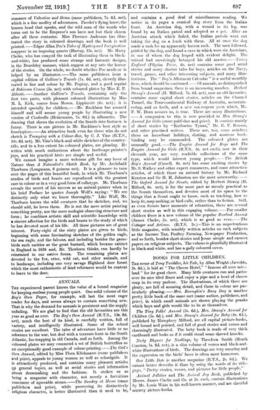GIFT BOOKS.
ILLUSTRATED BOOKS.
MME. Yuxio Oulu, the wife of the well-known Japanese politician, has translated some interesting and dramatic Romances of Old Japan in a handsome volume illustrated with many colour-prints by a Japanese artist (Simpkin, Marshall, 30s. net). These stories are less simple and humorous than the delightful Japanese fairy-tales which Mme. Ozaki translated some years ago. The tragic " Loyal even unto Death " is typical. In this a man and woman let their only son be killed in place of the son of their feudal chief. It is a grim story, told with considerable power. The opening tale, " The Quest of the Sword," recalls in a somewhat similar way the dog-like devotion of the retainer for his lord in old Japan. " Tlfe-Lady of the Picture " is, more or less, a Japanese version of Pygmalion and Galatea. "A Cherry Flower Idyll" is pure romance and thoroughly Japanese. Milne. Ozaki's very readable tales gain by being associated with native pictures, though the artist seems to have been influenced by Western painting.—We are glad to see Mr. S. R. Littlewood's spirited rendering of the good"old romance of Valentine and Orson (same publishers, 7s. 6d. net), which is a fine medley of adventures. Pacolet's flying horse, the brazen head that speaks, and the wild man of the woods who turns out to be the Emperor's son have not lost their charm after all these centuries. Miss Florence Anderson has illustrated. the story in coloured drawings, and the book is well printed.—Edgar Allan Poe's Tales of Mystery and 1 lamination, reappear in an imposing quarto (Harrap, 15s. net). Mr. Harry Clarke, who has essayed the task of illustrating them in blackand-white, has produced some strange and fantastic designs, in the Beardsley manner, which suggest at any rate the horror of the stories. On the whole, we doubt whether Poe needs or is helped by an illustrator.—The same publishers issue a capital edition of Gulliver's Travels (7s. 6d. net), cleverly illustrated in line and colour by Mr. Pogitny, and a good reprint of Robinson Crime (5s. net) with coloured plates by Miss E. P. Abbott.—Another Gulliver's Travels, containing only the first two parts, with pleasant coloured illustrations by Miss M. L. Kirk, comes from Messrs. Lippincott (6s. net) ; it is intended specially for children.—Mr. Rackham has amused himself and will amuse young people by illustrating a new version of Cinderella (Heinemann, 7s. 6d.) in silhouette. The drawing that shows the evolution of the lizards into footmen is funny. There is one picture in Mr. Rackham's best style as frontispiece.—An attractive book even for those who do not sketch is Tramping with a Colour-Box, by C. J. Vine (R.T.S., 103.6d. net). Mr. Vine's black-and-white sketches of the countryside, and to a less extent his coloured plates, are pleasing. He writes with much enthusiasm about the landscape-painter's joys, and his practical hints are simple and useful.
We cannot imagine a more welcome gift for any lover of Nature than A Naturalist's Sketch Book, by Mr. Archibald Thorburn (Longmans, 6 guineas net). It is a pleasure to turn over the pages of this beautiful book, in which Mr. Thorburn's studies of birds and beasts are reproduced with the greatest care in colour or in a very good form of collotype. Mr. Thorburn reveals the secret of his success as an animal-painter when in his brief Preface he quotes Joseph Wolf's saying : "We see distinctly only what we know thoroughly." Like Wolf, Mr. Thorburn knows the wild creatures that he sketches, and, we should add, he loves them. He is not the mere artist painting something pretty, nor the mere zoologist observing structure and form ; he combines artistic skill and scientific knowledge with a sincere affection for the birds and beasts to the study of which he has devoted most of his life. All these pictures are of great interest. Forty-eight of the sixty plates are given to birds, beginning with some fascinating sketches of the golden eagle, the sea eagle, and the falcons, and including besides the gamebirds such rarities as the great bustard, which became extinct in England in 1838 and, Mr. Thorburn thinks, can hardly be reinstated in our native fauna. The remaining plates are devoted to the fox, otter, wild cat, and other animals, and to landscape, including one very savage Highland deer forest which the most enthusiastic of land reformers would be content to leave to the deer.







































 Previous page
Previous page